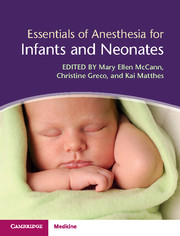Book contents
- Essentials of Anesthesia for Infants and Neonates
- Essentials of Anesthesia for Infants and Neonates
- Copyright page
- Contents
- Contributors
- Preface
- Section 1 Newborn and Infant Physiology for Anesthetic Management
- Section 2 Newborn and Infant Anesthesia
- Section 3 Specific Newborn and Infant Procedures
- Section 4 Pain Management and Other Newborn and Infant Anesthesia Concerns
- Index
- References
Section 1 - Newborn and Infant Physiology for Anesthetic Management
Published online by Cambridge University Press: 09 February 2018
- Essentials of Anesthesia for Infants and Neonates
- Essentials of Anesthesia for Infants and Neonates
- Copyright page
- Contents
- Contributors
- Preface
- Section 1 Newborn and Infant Physiology for Anesthetic Management
- Section 2 Newborn and Infant Anesthesia
- Section 3 Specific Newborn and Infant Procedures
- Section 4 Pain Management and Other Newborn and Infant Anesthesia Concerns
- Index
- References
- Type
- Chapter
- Information
- Essentials of Anesthesia for Infants and Neonates , pp. 1 - 98Publisher: Cambridge University PressPrint publication year: 2018



